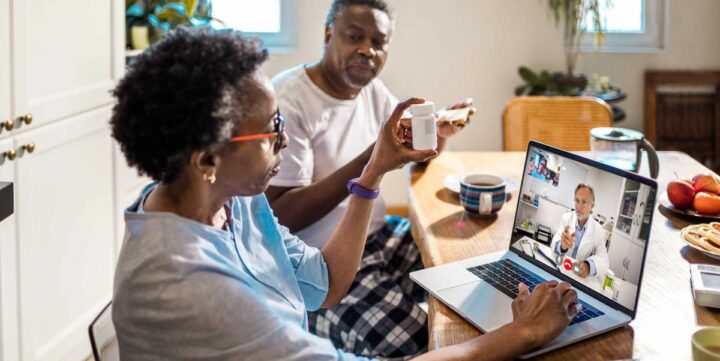Is Telehealth the new norm?
February 21, 2023
History
Did you know that the world’s first telephone call, made by Alexander Graham Bell in 1876, was effectively a request for medical help? Fast forward almost 150 years and here in Australia, health practitioners in 2022 alone delivered 118.2 million telehealth services to patients in need.
Telehealth is a broad term that encompasses all components and activities of healthcare and the healthcare system, which are conducted through telecommunications technology. Telemedicine is a component of telehealth and is defined by Oxford’s as ‘the remote diagnosis and treatment of patients by means of telecommunications technology’.
Since the era of COVID-19 and scattered fear in the workforce, all occupations and services have recognised a need for remote access to healthcare, prompting a significant pressure on health services to have access to technology, understanding of telehealth services, and above all, deliver the highest quality healthcare without the need for face-to-face appointments. There have been forecasts of a 64% growth in telehealth consultations throughout COVID-19, and with expanding accessibility, it doesn’t look as though the demand for telehealth medicine is slowing down any time soon. As employers look for new and innovative ways to manage their workforces remotely, telehealth providers are growing concerned about the support and sustainability of these services over time.
COVID-19 changes
Through the rise of the COVID-19 pandemic, we saw the need for Medicare and PBS to increase remote access to telemedicine. Whilst these telehealth appointments can prove the only method of healthcare for some during isolation and acute disease, evidence suggests this new normal risks deepening existing health disparities already made worse by the pandemic.
MBS telehealth introduced on a temporary basis has been made permanent following growing pressures by GPs, medical practitioners, nurse practitioners and allied health practitioners to allow an option to patients seeking follow-up or consultation where appropriate. The regulating factor? It remains a legislative requirement that GPs and other medical practitioners can only perform a telehealth service where they have an established clinical relationship with the patient, with limited exemptions. This established relationship does not apply to:
– Children under the age of 12 months
– People who are homeless
– Patients receiving an urgent after hours service
– Patients of medical practitioners at an Aboriginal Medical Centre or an Aboriginal Community Controlled Health Service
– People who are in a COVID-19 Government-declared hotspot (exemption not currently active)
– People isolating because of a COVID-related State or Territory public health order, including in quarantine
– People living in a flood-affected area, defined as a State or Territory local government area which is currently declared as a natural disaster area due to flood by a State or Territory Government.
AND patients accessing specific MBS items for:
– Blood borne viruses, sexual or reproductive health consultations
– Pregnancy counselling services
– Mental health services
– Nicotine and smoking cessation counselling
Are these the only populations who benefit from a future with telehealth? How can telehealth remain regulated to provide the best patient care and not just a simpler option?
Who is it Telemedicine best suited to
Perhaps the greatest value of telemedicine lies in the close monitoring and follow-up of patients unable to visit the clinic. Remote patient monitoring is not a new concept to general practice, and is a cornerstone of family healthcare. These include in some cases monitoring symptoms, pulse rate, blood pressure, temperature and saturation of oxygen (SpO2) via remote monitoring – a process made more accessible during the COVID-19 pandemic. In addition, telehealth benefits the preservation of health practitioners in the workforce during trying times. Telehealth aids to mitigate the risk of practitioners acquiring infection, and atop this, allows infected parties to remain working when they are fit to do so but clinically infectious. We learnt that health practitioners are precious resources during such events as the COVID-19 pandemic, and reducing the risk of disease in any way is beneficial to all. Whilst general practitioners remain under pressure to keep up with growing patient lists and scope of practice, the options for telemedicine remain pinnacle to the progress of general practice medicine in these stressful times.
Limitations of Telemedicine
Although for most patients, the convenience and accessibility of telehealth consults is a perk, not all benefit from this move. Patients in rural and remote areas, as well as those from socio-economically or educationally disadvantaged backgrounds, may find that accessibility to telehealth is not adequate. Lack of infrastructure, technological understanding and application are the key reasons that telemedicine is not suited to the elderly population; despite these populations being often the most socially isolated. Those early in their disease journey may also not benefit from telemedicine, nor those where English is not their first language. As communities continue to suffer from the inequalities widened by the COVID-19 pandemic, it is incumbent on policy makers and health systems to ensure that the solution doesn’t exacerbate the problem.
Moving Forward
Telemedicine ticks a lot of potential boxes—convenience, reduced costs, and mitigation of the paucity of clinical staff and specialists, to name a few. Although there are significant limitations, the process is slowly being ironed out by necessity during the COVID-19 pandemic. With the education and application around telemedicine improving over time, ensuring that healthcare remains universally accessible is vital to the progression of digital health for the future.
The Lancet Rheumatology (2022). Telemedicine: is the new normal fit for purpose? The Lancet Rheumatology, 4(1), p.e1. doi:https://doi.org/10.1016/s2665-9913(21)00399-4.
Rowlands, L. (n.d.). The critical role of telehealth and technology in the ‘new normal’. [online] www.dhs.net.au. Available at: https://www.dhs.net.au/news/free-white-paper-the-role-of-telehealth-in-the-new-normal [Accessed 20 Feb. 2023].
Iyengar K , Vaish A , Toh E , et al. COVID-19 and remote consulting strategies in managing trauma and orthopaedics. Postgrad Med J 2020;96:438–9. doi: 10.1136/postgradmedj-2020-137917












